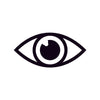Blog
Children with vision problems may experience difficulties in school and other social settings. However, they may be too young to know they have poor eyesight.
As a parent, it’s your responsibility to be attentive to your kid’s eye health and be on the lookout for any potential visual impairment your child may have. Your child may need an eye check-up if they are squinting, have a habit of sitting too close to the television or playing video games in poorly lit areas.
Regular eye exams and early detection are essential for a healthy childhood. You must therefore plan to have your kid’s eyes examined as they grow. After their first consultation, your child’s eye doctor will determine their eye health and schedule eye tests as needed.
Looking after young eyes
Most young children have their vision evaluated as part of standard developmental examinations for kids. While these are crucial to monitoring the growth and development of your child, an in-depth kids' eye test by a licensed optometrist is more thorough. This is because such examinations are specially designed to diagnose children’s eye diseases.
What age should you take your child in for an eye test?
Your child’s first eye test should ideally take place by age 3.
Learning and behavioural issues brought on by poor eyesight may be mistakenly attributed to other factors, especially when it comes to young children who cannot articulate their vision challenges. If detected sooner, conditions like frequent squinting, amblyopia or lazy eye can be treated more successfully.
Therefore, eye testing before your child enters a full-time education program ensures that any issues they may have are found early on and addressed. This will help set them up for a successful and joyful school life. With their vision problems corrected, your child won’t have difficulty focusing on schoolwork and will enjoy their daily activities with ease.
Things to look out for
Knowing your child has eyesight problems may not be easy, especially if you don’t know what signs you should look for.
Below is a list of indicators you can use to know if your child needs to get their vision checked.
- Squinting, head tilting or straining their eyes to see better
- Inability to read without using their finger
- Holding things close to their face or sitting too close to the television
- Frequent headaches or tired eyes
- Habitual eye rubbing
- Watery eyes or light sensitivity
- Difficulty with their studies
- Trying to see with only one eye
- Avoiding activities that require near vision (reading, working on school projects) or distance vision (athletic activities)
- Crossed or lazy eyes
- Inflammation or eye infection
- Short attention span
- Misdirection or turning in one or both eyes
- Presence of a white reflection (similar to a red eye) in the eyes of your child in their pictures
How often should kids have their eyes tested?
To answer the question ‘how often should kids have their eyes tested‘, the recommended eye test frequency for both children and adults is every two years.
However, even newborns, babies and very young children need vision screening. Some doctors also recommend yearly kids’ eye tests once children enter school.
Testing children’s eyes
Children’s eye exams are different from those administered to adults. Instead of the conventional charts you may be familiar with, specially created charts help kids recognise shapes or pictures and enable letter matching. This means that even if a child cannot read, their eyesight can still be tested thoroughly.
Optometrists are aware that visits to clinics are usually daunting for children. But since they are trained to give kids eye tests, they employ strategies to make eye exams as pleasant for their young patients as possible.
Types of eye conditions
There are several common eye conditions detected in children. These include:
- Squint or strabismus — This problem refers to the misalignment of the eyes where one eye may turn in or out. When wearing eyeglasses and practising eye exercises don’t work, surgery is usually the recommended treatment for the squint eye, as it can help restore (normal) binocular vision.
- Astigmatism — Astigmatism results in blurry or distorted eyesight caused by the abnormal curvature of the cornea or lens. Prescription eyewear is usually recommended to treat astigmatism.
- Myopia or short-sightedness — Someone with myopia can only see objects or people close to them. Wearing the right eyewear can easily correct this condition.
- Hyperopia (long-sightedness) — Long-sighted children can only focus on things farther away from them and suffer from blurred vision when they try to read the normal way. This condition can be treated with eyeglasses.
- Amblyopia or lazy eye — When one of the eyes is diagnosed to be weaker, the patient is diagnosed with amblyopia. This causes the child to depend on the other, better eye. Treatment with eyeglasses is the usual course of action. An eyepatch may be used if eyeglasses don’t work; however, amblyopia treatment generally takes longer.
Other challenges to kids’ eye health include visual processing dysfunction, eye teaming problems, depth perception, 3D vision difficulties and many more.
With regular kids’ eye tests, undiagnosed vision problems can be identified, evaluated and treated early so they don’t get any worse.If you want to book an eye test for your child or have questions regarding our products and services, get in touch with 1001 Optical today!


